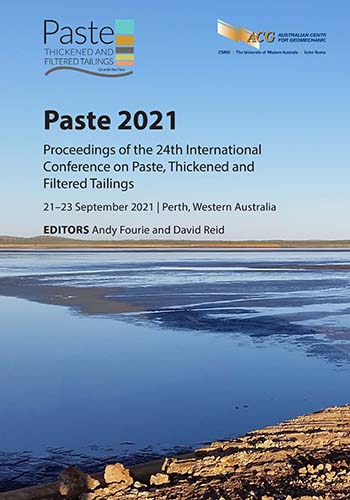Numerical modelling of dry stacking tailings heaps

|
Authors: Vizcarra, GC |
DOI https://doi.org/10.36487/ACG_repo/2115_19
Cite As:
Vizcarra, GC 2021, 'Numerical modelling of dry stacking tailings heaps', in AB Fourie & D Reid (eds), Paste 2021: Proceedings of the 24th International Conference on Paste, Thickened and Filtered Tailings, Australian Centre for Geomechanics, Perth, pp. 231-238, https://doi.org/10.36487/ACG_repo/2115_19
Abstract:
In the practice of geotechnical engineering applied to mining, dry stacked tailings heap projects are analysed by limit equilibrium methods and stress-strain analyses. These methods and model assumptions do not consider the influence of the partially drained conditions, strain softening, and transition from overconsolidated to normally consolidated behaviour of the foundation. This situation can lead to calculations of deterministic safety factors that are often overestimated, according to the nature of the foundation. This article proposes a methodology for numerical modelling of the foundation during staged construction of a heap, and considers loading time as a critical variable in calculating the Factor of Safety of the heap dry stacked of elaborating a numerical model considering the foundation and construction. The physical and geotechnical properties of the materials were derived through the model, and are the interpretation of data obtained from a geotechnical investigation and laboratory testing campaign. Stressstrain analyses are performed for different stacking speed scenarios to assess its influence on the safety factor at each loading stage. The analyses are coupled, where the distribution of stresses and deformations within the foundation and the dissipation of porewater pressures over time are simulated. The results show the evolution of the Factor of Safety, the spatial distribution of the regions with excess porewater pressure, allowing the optimisation of both the rate of rise of the dry stack and external batter slope for the project to minimise ground improvement. It is observed that there is a strong dependence of the coefficient of permeability of the foundation soils on the porewater pressure dissipation time. Numerical modelling considering partially drained conditions allows greater understanding of foundation behaviour and performance during the development of the dry stacked heap. The analysis is considered applicable to both soft soil foundation conditions and conversion of existing wet disposal tailings facilities to dry stacking atop, referred to as ‘piggybacking’ within the mining industry.
Keywords: dry stacking tailings, modelling, partially drained
References:
Lara, JL, Pornillos, EU & Muñoz, HE 2013, ‘Geotechnical-geochemical and operational considerations for the application of dry stacking tailings deposits – state-of-the-art’, in R Jewell, AB Fourie, J Caldwell & J Pimenta (eds), Paste 2013: Proceedings of the 16th International Seminar on Paste and Thickened Tailings, Australian Centre for Geomechanics, Perth, pp. 249–260,
Martin, T & McRoberts, E 1999, ‘Some considerations in the stability analysis of upstream tailings dams’, Proceedings of the Sixth International Conference on Tailings and Mine Waste ‘99, Taylor & Francis, London, pp. 287–302.
Priscu, C 1999, Behavior of Mine Tailings Dams Under High Tailings Deposition Rates, PhD thesis, McGill University, Montreal.
Zardari, M 2011, ‘Stability of tailings dams’, licentiate thesis, Luleå University of Technology, Luleå.
© Copyright 2025, Australian Centre for Geomechanics (ACG), The University of Western Australia. All rights reserved.
View copyright/legal information
Please direct any queries or error reports to repository-acg@uwa.edu.au
View copyright/legal information
Please direct any queries or error reports to repository-acg@uwa.edu.au





